Grand Council of Fascism
The Grand Council of Fascism (Italian: Gran Consiglio del Fascismo, also translated "Fascist Grand Council") was the main body of Mussolini's Fascist government in Italy. A body which held and applied great power to control the institutions of government, it was created as a body of the National Fascist Party in 1923 and became a state body on 9 December 1928. The council usually met at the Palazzo Venezia, Rome, which was also the seat of head of the Italian government.[1] The Council became extinct following a series of events in 1943, in which Benito Mussolini was voted out of the Prime Ministry of Italy.
Gran Consiglio del Fascismo | |
.svg.png.webp) Coat of Arms | |
| Abbreviation | Grand Council |
|---|---|
| Formation | 9 December 1928 |
| Dissolved | 25 July 1943 |
| Legal status | Constitutional body |
| Headquarters | Palazzo Venezia, Rome |
| King Victor Emmanuel III | |
| Benito Mussolini | |
Members of the Council
Its members, selected among the party's gerarchi, are below. Their vote on the 25 July 1943 motion to depose Mussolini is also given next to their name (Sì for aye, No for nay), if they voted.
The Head of Government and Duce of Fascism
| Portrait | Name (Birth–Death) |
Term of office | 25 July 1943 Motion | |
|---|---|---|---|---|
 |
Benito Mussolini (1883–1945) |
9 December 1928 |
25 July 1943 |
Deposed |
The Quadrumvirs
| Portrait | Name (Birth–Death) |
Term of office | 25 July 1943 Motion | |
|---|---|---|---|---|
.jpg.webp) |
Italo Balbo (1896–1940) |
9 December 1928 |
28 June 1940 |
Died in Office |
 |
Michele Bianchi (1883–1930) |
9 December 1928 |
3 February 1930 |
Died in Office |
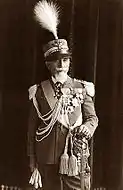 |
Emilio De Bono (1866–1944) |
9 December 1928 |
25 July 1943 |
Sì |
 |
Cesare Maria De Vecchi (1884–1959) |
9 December 1928 |
25 July 1943 |
Sì |
President of the Senate
| Portrait | Name (Birth–Death) |
Term of office | 25 July 1943 Motion | |
|---|---|---|---|---|
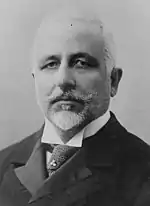 |
Tommaso Tittoni (1855–1931) |
9 December 1928 |
29 January 1929 |
|
 |
Luigi Federzoni (1878–1967) |
29 April 1929 |
2 March 1939 |
|
 |
Giacomo Suardo (1883–1947) |
15 March 1939 |
25 July 1943 |
Abstention |
President of the Chamber of Deputies
| Portrait | Name (Birth–Death) |
Term of office | 25 July 1943 Motion | |
|---|---|---|---|---|
 |
Antonio Casertano (1863–1938) |
9 December 1928 |
29 January 1929 |
Died in Office |
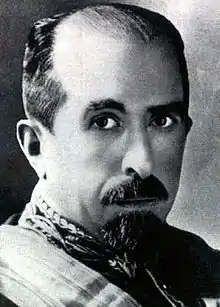 |
Giovanni Giuriati (1876–1970) |
20 April 1929 |
19 January 1934 |
|
 |
Costanzo Ciano (1876–1939) |
28 April 1934 |
2 March 1939 |
Died in Office |
| President of the Chamber of Fasces and Corporations | ||||
 |
Costanzo Ciano (1876–1939) |
23 March 1939 |
26 June 1939 |
Died in Office |
 |
Dino Grandi (1895–1988) |
30 November 1939 |
25 July 1943 |
Sì |
Agriculture and Forestry
| Portrait | Name (Birth–Death) |
Term of office | 25 July 1943 Motion | |
|---|---|---|---|---|
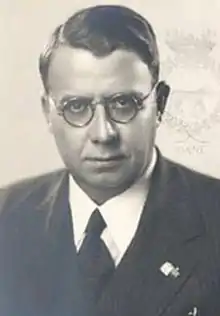 |
Giacomo Acerbo (1888–1969) |
9 December 1928 |
24 January 1935 |
|
 |
Edmondo Rossoni (1884–1965) |
24 January 1935 |
31 October 1939 |
|
 |
Giuseppe Tassinari (1891–1944) |
31 October 1939 |
26 December 1941 |
|
.gif) |
Carlo Pareschi (1898–1944) |
26 December 1941 |
25 July 1943 |
Sì |
Corporations
| Portrait | Name (Birth–Death) |
Term of office | 25 July 1943 Motion | |
|---|---|---|---|---|
 |
Benito Mussolini (1883–1945) |
9 December 1928 |
12 September 1929 |
Prime Minister and Duce |
 |
Giuseppe Bottai (1895–1959) |
12 September 1929 |
20 July 1932 |
|
 |
Benito Mussolini (1883–1945) |
20 July 1932 |
11 June 1936 |
Prime Minister and Duce |
 |
Ferruccio Lantini (1886–1959) |
11 June 1936 |
31 October 1939 |
|
 |
Renato Ricci (1896–1956) |
31 October 1939 |
6 February 1943 |
|
 |
Carlo Tiengo (1882–1945) |
6 February 1943 |
19 April 1943 |
|
| Tullio Cianetti (1899–1976) |
19 April 1943 |
25 July 1943 |
Sì | |
Finance
| Portrait | Name (Birth–Death) |
Term of office | 25 July 1943 Motion | |
|---|---|---|---|---|
 |
Antonio Mosconi (1866–1955) |
9 December 1928 |
20 July 1932 |
|
 |
Guido Jung (1876–1949) |
20 July 1932 |
17 January 1935 |
|
 |
Paolo Thaon di Revel (1888–1973) |
17 January 1935 |
6 February 1943 |
|
 |
Giacomo Acerbo (1888–1969) |
6 February 1943 |
25 July 1943 |
Sì |
Foreign Affairs
| Portrait | Name (Birth–Death) |
Term of office | 25 July 1943 Motion | |
|---|---|---|---|---|
 |
Benito Mussolini (1883–1945) |
9 December 1928 |
12 September 1929 |
Prime Minister and Duce |
 |
Dino Grandi (1895–1988) |
12 September 1929 |
20 July 1932 |
|
 |
Benito Mussolini (1883–1945) |
20 July 1932 |
9 June 1936 |
Prime Minister and Duce |
 |
Galeazzo Ciano (1903–1944) |
9 June 1936 |
6 February 1943 |
|
 |
Benito Mussolini (1883–1945) |
6 February 1943 |
25 July 1943 |
Prime Minister and Duce Deposed |
Interior
| Portrait | Name (Birth–Death) |
Term of office | 25 July 1943 Motion | |
|---|---|---|---|---|
 |
Benito Mussolini (1883–1945) |
9 December 1928 |
25 July 1943 |
Prime Minister and Duce Deposed |
Justice and Religious Affairs
| Portrait | Name (Birth–Death) |
Term of office | 25 July 1943 Motion | |
|---|---|---|---|---|
 |
Alfredo Rocco (1875–1935) |
9 December 1928 |
20 July 1932 |
|
| Grace and Justice | ||||
 |
Pietro De Francisci (1883–1971) |
20 July 1932 |
24 January 1935 |
|
 |
Arrigo Solmi (1873–1944) |
24 January 1935 |
12 July 1939 |
|
 |
Dino Grandi (1895–1988) |
12 July 1939 |
5 February 1943 |
|
 |
Alfredo De Marsico (1888–1985) |
5 February 1943 |
25 July 1943 |
Sì |
Press and Propaganda
| Portrait | Name (Birth–Death) |
Term of office | 25 July 1943 Motion | ||
|---|---|---|---|---|---|
 |
Galeazzo Ciano (1903–1944) |
23 June 1935 |
11 June 1936 |
||
 |
Dino Alfieri (1886–1966) |
11 June 1936 |
27 May 1937 |
||
| Minister of Popular Culture | |||||
 |
Dino Alfieri (1886–1966) |
27 May 1937 |
31 October 1939 |
||
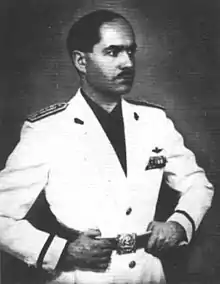 |
Alessandro Pavolini (1903–1945) |
31 October 1939 |
6 February 1943 |
||
 |
Gaetano Polverelli (1903–1945) |
6 February 1943 |
25 July 1943 |
No | |
Public Education
| Portrait | Name (Birth–Death) |
Term of office | 25 July 1943 Motion | ||
|---|---|---|---|---|---|
 |
Giuseppe Belluzzo (1876–1952) |
9 December 1928 |
12 September 1929 |
||
| National Education | |||||
 |
Balbino Giuliano (1879–1958) |
12 September 1929 |
20 July 1932 |
||
 |
Francesco Ercole (1884–1945) |
20 July 1932 |
24 January 1935 |
||
 |
Cesare Maria De Vecchi (1884–1959) |
24 January 1935 |
15 November 1936 |
||
 |
Giuseppe Bottai (1895–1959) |
15 November 1936 |
5 February 1943 |
||
 |
Giacomo Acerbo (1888–1969) |
5 February 1943 |
25 July 1943 |
Sì | |
President of the Royal Academy
| Portrait | Name (Birth–Death) |
Term of office | 25 July 1943 Motion | |
|---|---|---|---|---|
 |
Tommaso Tittoni (1855–1931) |
28 October 1929 |
16 September 1930 |
|
 |
Guglielmo Marconi (1874–1937) |
19 September 1930 |
20 July 1937 |
Died in Office |
 |
Gabriele D'Annunzio (1863–1938) |
12 November 1937 |
1 March 1938 |
Died in Office |
 |
Luigi Federzoni (1878–1967) |
21 April 1938 |
25 July 1943 |
Sì |
President of the Special Court for the Defence of the State
| Portrait | Name (Birth–Death) |
Term of office | 25 July 1943 Motion | |
|---|---|---|---|---|
| Guido Cristini (1895–1979) |
9 December 1928 |
28 November 1932 |
||
| Antonino Tringali-Casanova (1888–1943) |
28 November 1932 |
25 July 1943 |
No | |
Other Posts
- The Presidents of the Corporations; Industrialists, Agriculture Workers, Industrial Workers, and Farmers. The Nobel Physics laureate inventor-technologist Guglielmo Marconi was the President of the Academy of Italy, making him a council member.
- The Secretary of the National Fascist Party, who was also the secretary of the Council.
- Various people chosen by Mussolini himself, who each held appointments of three-year durations.
Powers of the Council

Essentially, the council held these powers:
- The power to elect the Fascist Party deputies, the nomination for the Party Secretary and other party leaders, the approval of the party statutes and the power regarding the party's policy.
- The power to elect the Crown's line of succession including the choice of the heir to the throne, the right of the crown, the power to choose possible successors to the Prime Minister, the power to choose the function and membership of the Grand Council, the Senate, the Chamber of Deputies (later the Chamber of Fasces and Corporations), the power to decide the rights and powers of the Prime Minister, international Treaties, and foreign affairs.
The Grand Council meetings were convened by the Prime Minister himself, and all decrees and laws could only be legalized after receiving his approval. In contrast to the Führerprinzip government model in Nazi Germany, the Grand Council retained the power to recommend that the King of Italy remove the Prime Minister from office. As all the former governing institutions had been subordinated to the Fascist party, the Council was the only check on Mussolini's power.
Overthrow of Mussolini
The Allies invaded Sicily in July 1943. Grand Council member Dino Grandi proposed a vote of no confidence in Mussolini as leader of the Council and the party. A vote was held on the night of 24–25 July 1943 and passed with 19 votes for, 8 against and one abstention. Among the 19 votes of no confidence were those of Mussolini's son-in-law Galeazzo Ciano, who had been former minister of foreign affairs, and the influential marshal Emilio De Bono.
The following day King Victor Emmanuel met Mussolini and informed him that General Pietro Badoglio would lead Italy, as Prime Minister. Mussolini was arrested immediately after the meeting.[2]
In September 1943 Mussolini was freed from imprisonment by German commandos and helped to regain power in northern Italy. He had Ciano, De Bono and three others arrested and tried for treason on 8 January 1944 in Verona. They were executed by firing squad three days later.[3][4]
References
- "Gran consiglio del fascismo". Enciclopedia on line (in Italian). Istituto della Enciclopedia Italiana fondata da Giovanni Treccani S.p.A. Retrieved 23 August 2017.
- Shirer, William L. (1959). The Rise and Fall of the Third Reich (2011 ed.). New York: Simon & Schuster. p. 997. ISBN 9781451642599. Retrieved 23 August 2017.
- Bosworth, Richard J. B. (2010). Mussolini (New ed.). London: Bloomsbury Publishing. p. 16. ISBN 9780340981733. Retrieved 23 August 2017.
- De Grand, Alexander J. (2000). Italian Fascism: Its Origins & Development (Third ed.). Lincoln, NV: University of Nebraska Press. p. 136. ISBN 0803266227. Retrieved 23 August 2017.
Further reading
- 2194 Days of War, Cesare Salmaggi & Alfredo Pallavisini (editors), Gallery Press, New York — ISBN 0831788852 (1977)
